Pruning Perennial Salvias
This is all about pruning perennial salvias so the plants stay healthy and flower in abundance.
Salvias are popular all the world over. I’ve seen them growing in England, the Canary Islands, Mexico, and many different places in the US. These plants are so versatile because they can comfortably fit into many styles of gardens, from old-fashioned cottage right up to modern, simplistic ones.
They grow well here in California, where our Mediterranean climate suits them to a tee, and they are loved because they have a long bloom time. Their non-thirsty ways make sense, given our lack of rainfall for many years.
NOTE: This was published in 2014. Rather than do an extensive update on this, I’ve done a newer post on Pruning & Trimming 3 Types Of Salvias In Spring Or Fall with more information you’ll want to check out.
I was a San Francisco Bay Area professional gardener for over 20 years. This is where I first learned all about perennial salvias. The nursery where I worked in Berkeley sold many different species and varieties. This post is all about sharing what I know about pruning the two most popular types of perennial salvias you probably have in your garden.
This is Salvia officinalis (with the lavender flower) or Culinary sage, which is perennial here in Santa Barbara but an annual in colder climates. It is a semi-shrubby (or shrublet if you prefer to call it that), woody salvia which falls into the pruning category 1. It’s smaller than the greggi below, so I would only cut it back by 6-8″ after flowering. Then, you can dry the leaves to use for cooking.
I’m going to talk about pruning salvias here in coastal California. You can tweak the process for your climate zone if they’re also perennials where you live. The first type is the herbaceous salvias with woody stems. These are the shrubby salvias.
A few that fall into this category that you may know are Salvia greggii (there are so many of these!), S. chamaedryoides, S. coccinea and S. microphylla. There are quite a few microphyllas, too – the one you see in the video is “Hot Lips.” These you prune back after flowering but not all the way.
This is Salvia greggi, a common landscape plant. It has woody stems & also falls in the 1st pruning category. After each flowering cycle, I would take it down by at least a foot.
Take them back to at least where the first set of foliage starts on the flower stem – this could be a pinch, or you can take them down further if you’d like. I learned the hard way on an established plant to not cut it down to 3″. It never fully came back; out it came, and into the compost it went.
With these types of salvias, I thin out the middle a bit and then shape the plant so it’s pleasing to the eye. They usually go through 3 bloom cycles throughout the year here. We have a long growing season. I would give them a mild pruning in the fall and a more intense one in the late winter or early spring if needed.
There’s the whole fall pruning versus spring pruning debate. I don’t prune the plants with a little more substance in the fall and leave them be over the winter. Then, I do an early spring haircut and shaping.
Be sure to take out any growth that has died over the winter. If you don’t give these salvias some pruning, they will get extremely woody and won’t repeat bloom like you want them to.
In my years working with salvias, I found that some needed to be replaced before or around the 5-year mark. This is especially true with this type. Some perennials don’t live forever, after all.
They tend to get straggly over time. No worries if you have to replace any because they grow fast, especially if you purchase a 1-gallon plant.
This is Salvia leucantha or Mexican Bush Sage. They’re deciduous salvias with soft stems & fall into the 2nd pruning category. Once the stems have flowered & died off, cut them to the ground.
Second up are the deciduous herbaceous salvias. The old growth eventually dies out, and the fresh new growth emerges from the base of the base.
They have softer stems that either die off and/or freeze. Plants that fall into this category are Salvia elegans, S. guaranitica, s. leucantha, s. waverley and s. patens. In the video you see me working on a Salvia leucantha or Mexican Bush Sage. These salvias are very simple to prune.
When it’s through flowering, cut those stems down to the ground. It needs to be done once or twice a year. They will still flower if you don’t, but you’ll get more blooms, and the plant will look 100% better if you do.
Here in Santa Barbara, the leucanthas and the Waverleys get huge. Many of them are not cut back, leaving a tangle of dead, twisted stems, and they look like a ratty mess. It’s best to give them the shearing back they need.
You’ll see the soft new growth appearing at the base. Another thing to know is that these salvias tend to spread as they grow, so you might have to do a bit of dividing.
This is Salvia spathacea or Hummingbird sage, which is also a deciduous perennial, pruning category 2. In the left foreground is the new growth. Cut the flower stalks (the old growth) in the back down to the ground after they’re completely spent.
Knowing what kind of salvia you have is best before jumping into action with the pruners. Both of these types of salvias benefit from a good haircut.
You’ll get a much better bloom and shape if you do so. No ratty-looking plants in our gardens, please!
Note: This was published in 2014. Rather than do an extensive update on this, I’ve done a newer post on Pruning & Trimming 3 Types Of Salvias In Spring Or Fall with more information you’ll want to check out.
In the video below, you’ll see me pruning these two types of salvias. Enjoy!
This post may contain affiliate links, you can read our policies here.
- About the Author
- Latest Posts
Nell, the founder of Joy Us garden, was born into a gardening family and grew up in Connecticut’s countryside. After living in Boston, New York, San Francisco, & Santa Barbara, she now calls the Arizona desert home. She studied horticulture & garden design, working in the field all her life. Nell is a gardener, designer, blogger, Youtube creator, & author. She’s been gardening for a very long time & wants to share what she’s learned with you.
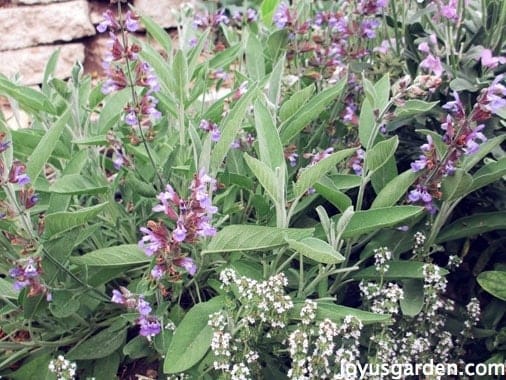
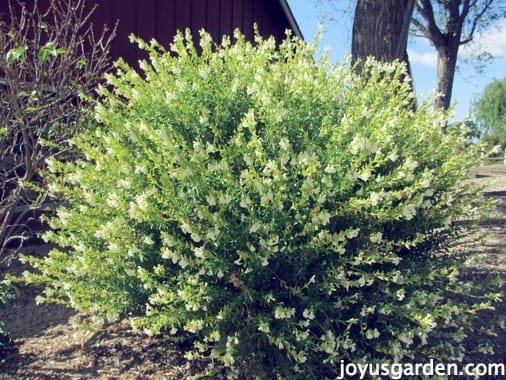
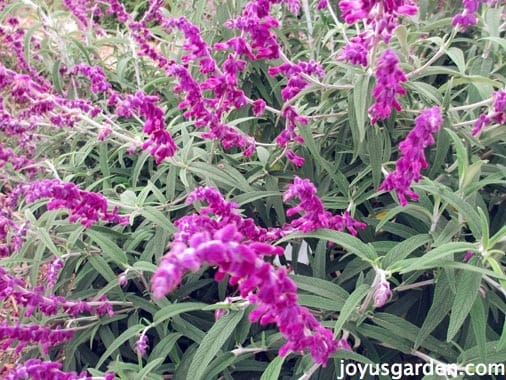
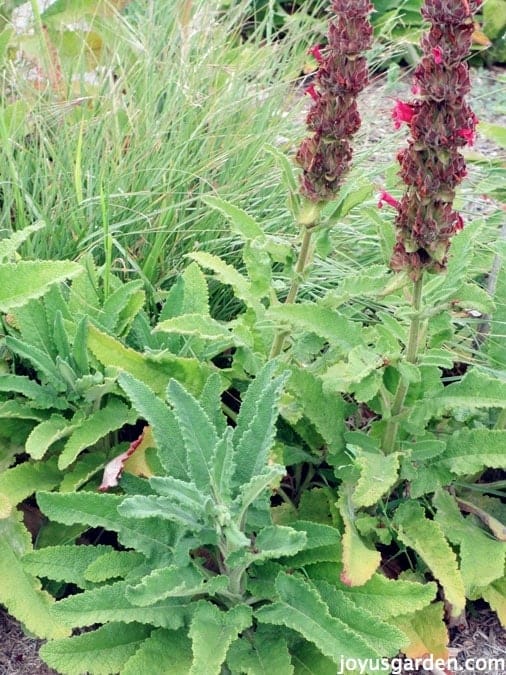

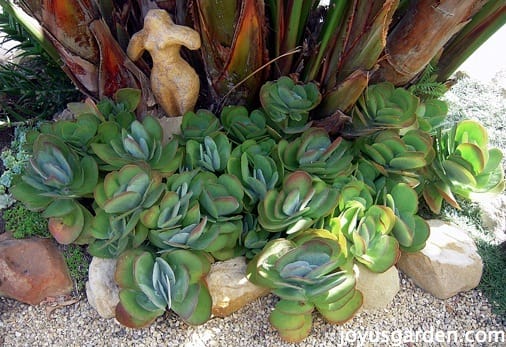
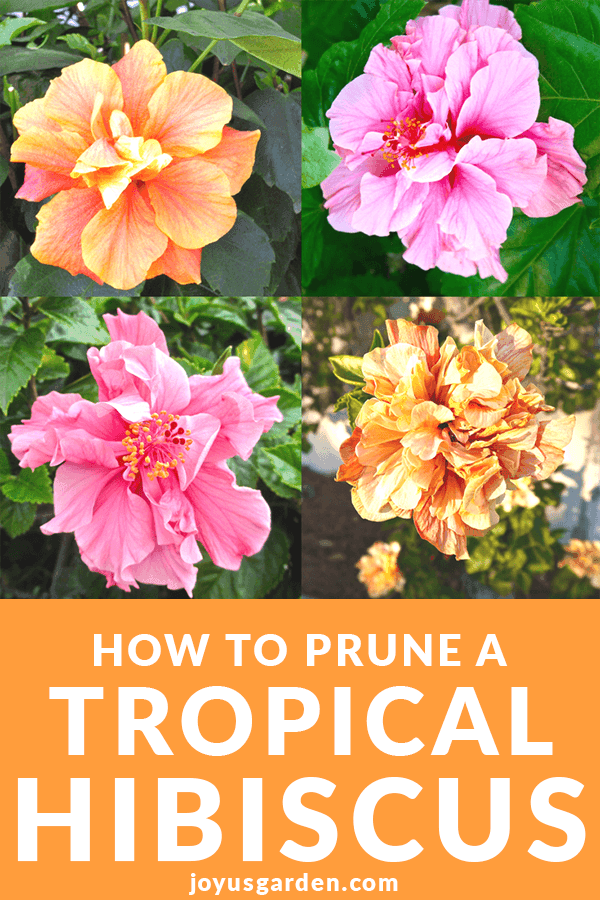
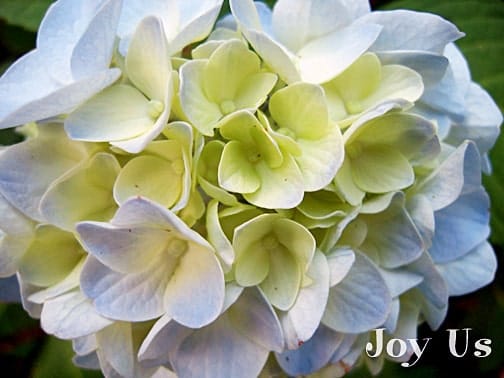
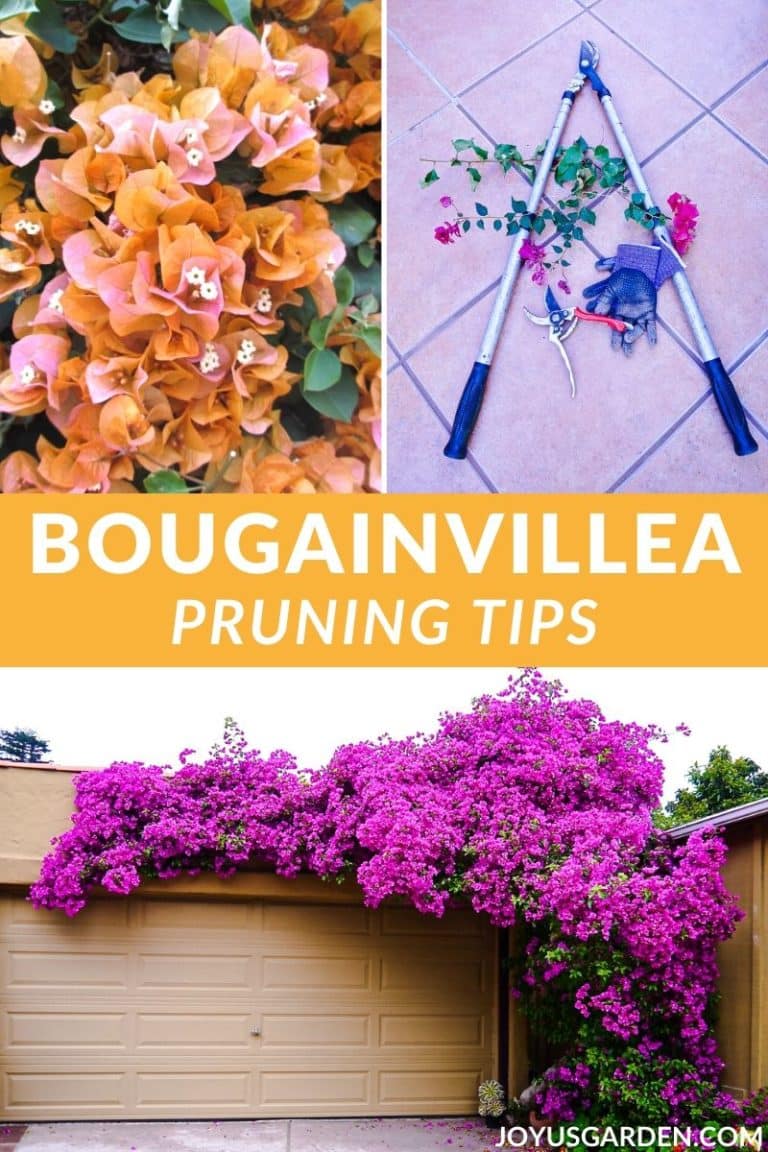

I planted mystic spires blue salvia in April and It is spreading more than I expected. Is it OK to prune it in midsummer? Should I prune it in Fall or Spring? Can you also give me tips in pruning this plant?
I live in Fort Worth, Texas.
Thanks.
Hi Manoj –
Thanks a great salvia & would grow vigorously in the warm Texas summer. Prune it back by 1/2 now (mid-summer) & then take it down to about a foot from the ground in late winter or early spring, whenever danger of frost has passed. Hope that helps! Nell
Hi, Nell,
Thanks for this great site! Can you stand another question? I’ve got black and blue salvia here in Coastal Georgia (zone 8b). I’ve also got the worst Cottony Cushion Scale problem you can imagine. Since we’re pretty warm year round, the salvia are still blooming — that is to say, as well as they can given the infestation. Any suggestions on how to get rid of the scale? I believe they came in on the plants and I’m very concerned about them spreading to the rest of this bed and into the other gardens.
Thanks,
Dyana
Hi Dyana – You’re very welcome! Scale can be very hard to control because of its protective shell, especially when the infestation is bad. I’ve used horticultural oil in late winter through fall to control hard scale or alcohol (if the infestation is manageable). I have no experience with Cottony Cushion Scale but I do know there is a biological control which is a beetle. I’d check with your local agricultural extension office & see what they have to say. Best, Nell
Your pruning video was very helpful! My hot lips leaves have gone from a green to a dark purple/brown color. Not sure if this is natural and I should prune…or let them go as is. I’m in the bay area.
Hi Kat – I lived in SF for 20 years so I’m very familiar with that area. Yes, it’s very normal. I now live in Tucson & my Salvia Hot Pink is doing it also. It’s just a reaction to cooler temps. Salvias love sun & heat! Nell
Hi Nell! I live in Modesto and my salvias tend to get a pest that makes little foamy spots all over the plants. Can you tell me if there’s an effective organic/natural way to treat this?
Also I have a Black and Bloom (like black and blue) that I did not cut back and now it has woody stems with leaves and blooms at the tops but looks ugly. What can I do to get it nice looking again? Cut some of the stems and leave some to continue the plant growth? And if so, how short can I cut them right now? Also I pegged down a branch but haven’t checked…will this root? The top of the branch looks nice and is blooming now.
Thank you!
Hi Nell, I enjoyed your post! I live in Modesto. How would you recommend pruning Black and Bloom salvia? The tag identifies it as salvia Mexicana.
Also, I have a Black and Blue that I did not prune and the stems are kind of woody and about 2 ft. tall with no leaves except on the tops. Should I prune this down even though there are no lower leaves and no leaves at the base?
Thank you!
Hi Jacqui – Your salvias are getting spittlebug. It rarely harms the plant but is unsightly. I always spray it off with the garden hose. You can also make a homemade spray by doing a search. Cut your black & broom (a version of black & blue) back by about 1/3. Yes, the branch might root. Hope that helps, Nell
Thanks very much, Nell! So, it’s OK to cut black & bloom back and not have any leaves on it? I’m always afraid of doing that with salvia since I killed one doing that once. Thanks!